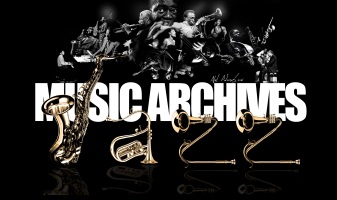
 |
Book Review: Gene Krupa –“Master of the Drums” |
Post Reply 
|
| Author | |
snobb 
Forum Admin Group 

Site Admin Joined: 22 Dec 2010 Location: Vilnius Status: Online Points: 30661 |
 Post Options Post Options
 Thanks(0) Thanks(0)
 Quote Quote  Reply Reply
 Topic: Book Review: Gene Krupa –“Master of the Drums” Topic: Book Review: Gene Krupa –“Master of the Drums”Posted: 9 hours 24 minutes ago at 4:36am |
|
Chronicling Gene Krupa’s ups and downs and registering his impact on contemporary music, Master of the Drums is a well-deserved account of one of the key musical artists of the past century. Master of the Drums: Gene Krupa and the Music He Gave the World, by Elizabeth J. Rosenthal. Citadel, 400 pages, $39
In Master of the Drums, author Elizabeth Rosenthal takes a deep dive into the career and the life of Gene Krupa (1909-1973), arguably the most influential drummer of the 20th Century. Among his contributions: he helped create the modern drum set, stood up for racially integrated jazz ensembles, and demonstrated that a percussionist could do much more than just keep time. Krupa was influenced by the great stick men of the ’30s and ’40s, like Baby Dodds, Chick Webb, Jo Jones, and Cozy Cole. He expanded on their artful histrionics, while his powerful and steady backbeat set the pattern for later generations of both rock and jazz percussionists. Chronicling Gene Krupa’s ups and downs and registering his impact on contemporary music, Master of the Drums is a well-deserved account of one of the key musical artists of the past century. There’s plenty of proof that the parents of a generation of white drummers exposed their kids to Krupa’s sound. John Bonham and Ringo Starr are among the celebrated drummers who claim Krupa as their drum hero. To Bonham, “Krupa was a God.” Steve Gadd, one of today’s top session players, has said that “everything about Gene influenced me, his playing, his charisma — he was special … his groove is in my head.” Krupa likely introduced the famous ‘Bo Diddley’ rhythm, which has been used in a number of popular songs, such as Buddy Holly’s ‘Not Fade Away’, later covered by the Rolling Stones. (Rosenthal lists the tunes based on that beat.) The Krupa ancestors landed in America from Poland in the late 1800s, initially settling in Pennsylvania. Gene’s father, Bartley, was a day laborer who raised the family in Chicago. At the time, the city was a “tough, violent, chaotic” world. One of Krupa’s brothers was murdered at the age of 11. Gene was 16 when his father “died of an infected boil.” Understandably eager to move beyond this difficult upbringing, Gene took to the drums and dedicated himself to excelling at music. White musicians were just beginning to catch on to jazz styles; Krupa’s influences came from watching great Black performers. Krupa’s family didn’t think much of his enthusiasm. His mother told him that, if he agreed to study for a year at a seminary, she would permit him to pursue the drums. Gene assented and began working at learning what was necessary to make a living playing jazz. Chicago offered the fledgling drummer invaluable opportunities to see legendary musicians, such as Zutty Singleton, whose style came from New Orleans roots jazz. (Here is a clip of Singleton with Fats Waller. Solo at 1:25). Krupa also studied the playing of Baby Dodds. (Krupa cited him as a major influence.) Dodds’s distinctive style featured long buzz rolls (where the stick is pressed into the drum head for a buzzing snare drum sound). He was also known for his ‘shimmy beat,’ which consisted of rapid playing with offbeat accents. Singleton and Dodds served as early models for Krupa’s approach to performance.
Despite his popularity, Krupa was not without his critics. Producer Hammond and jazz critic Leonard Feather admired his talent, but “disagreed with the notion that drums were a solo instrument.” Some detractors claimed Krupa would speed up tempos or play too loudly. His performances were intentionally exuberant, and this theatricality had plenty of defenders. Rosenthal salutes what she calls Krupa’s “duende” (a term drawn from a lecture written by poet Federico Garcia Lorca), a passion that “surges from the inside.” Propelled by “an almost religious enthusiasm,” the artist is pushed “to the precipice of pure emotion.” The word aptly describes the exhilaration of Krupa’s drumming dramatics. Here is a description from an eyewitness: “bouncing, swaying, head shaking, grimacing. As a child, I vividly recall seeing him from the doorway of the Metropole Café in Times Square, a regular venue for his band. There he was, bug-eyed, hunched over the drums, wailing away, his hair hanging in his face. For me, it was brief but unforgettable. Some traditionalists thought his approach to the instrument was vulgar. But others said, ‘He burns – with divine fire.'” Like Elvis, Krupa was, according to Rosenthal, “a combination of sex and sensuousness.” He certainly cultivated female fans. His appetite is evident in this film clip from George White’s Scandals (1945) where you can see him surreptitiously jotting down the names of auditioning chorus girls. Krupa was a spirited driver behind many big bands, most notably, Benny Goodman’s. Jazz historian Grover Sales went as far as to claim that Krupa was a prime force behind the swing craze of the ’30s: “Krupa’s tribal beat formed the hypnotic pulse that changed the way America danced, listened and responded to music.” He was also the first to establish that the drums could be a solo instrument and came up with the essentials of the drum set: a snare drum, two tom-toms mounted on a single bass drum, a floor tom, cymbals on stands, and a cowbell. He marketed that arrangement; in 1935 became a celebrity endorser for Slingerland Drums. In addition to the renowned Radio King snare drum, his set featured an elegant marine white pearl finish. He had Slingerland Drums design toms that were fully tunable, top and bottom (as they are today), for more expansive solos. He also studied with teachers whose methods shaped the modern vision of drumming. Among them was Sanford Moeller, whose technique maximized a flexible use of the arm and wrist. The efficiency of Moeller’s strokes, some of which originated from military drumming, contributed to Krupa’s supercharged style. Billy Gladstone of the Radio City Music Hall Orchestra, who developed the well-known rubber practice pad, was another useful instructor. From him, Krupa learned that a drummer’s job — in addition to showmanship — was to “prevent listlessness” or “moodiness” in his sidemen, to keep the music zipping along. One signature feature of Krupa’s playing was the ‘crackling rim shot,’ the sound created by hitting the shaft of the stick between the drum head and the rim. He would anticipate beats with a rim shot, driving the arrangements forward with nonstop vivacity. He was also one of the first drummers to employ the idea of 4-way coordination. Krupa explained that “you have to use both feet and both hands on different instruments (drums) at the same time.” Krupa wrote one of the first instructional books on modern drum techniques, 1938’s Drum Method. It supplied examples of cymbal usage, stick positioning, and rudiment exercises. Though his influence on other drummers was profound, Krupa remained humble and generous throughout his career. For example, he routinely mentored rookie percussionists, such as young Mel Lewis, who watched Krupa from the sidelines.  Sal Mineo and Susan Oliver in 1959’s The Gene Krupa Story. Throughout Krupa’s career, he collaborated with, or assisted, other musicians. Wild live drum battles with Cozy Cole were followed by discussions between the two about finding a way that they could travel less. The result was the New York City Gene Krupa-Cozy Cole Drum School. Advertising for the program featured their two grinning faces, a rarity in the segregated America of 1954. Louis Bellson was the first winner of “Gene Krupa’s Amateur Swing Drummer’s Contest.” “That kid . . . he’s a hell of a fine drummer” crowed Krupa. Bellson was from a musical family and went on to tour with Harry James, Tommy Dorsey, Count Basie, Duke Ellington and others. Many other accomplished drummers were nurtured by Krupa. One of them, Sonny Igoe, said that “Gene adopted me as a kind of protégé.” Among many other bands, Igoe was in the NBC and CBS television orchestras. The cantankerous and vain Buddy Rich, perhaps the world’s most gifted drummer, admitted he was influenced by Krupa. The two were on an LP that has been re-released under the title Drum Battle – Gene Krupa and Buddy Rich Drum at JATP. (One such battle can be heard on YouTube.) As previously mentioned, many contemporary rock drummers were impacted by Krupa’s vigorous style and vivacious flair. Actor Peter Sellers, who was a decent drummer before he became a comic master, labeled himself as “Britain’s Answer to Gene Krupa”. Eight-year-old Colin Peterson was invited to sit with Krupa at his hotel in Australia, where he gave the lad pointers. Peterson went on to play for the Bee Gees. The book is exhaustive in its listing of dates and key jazz figures who intersected with Krupa’s career. I often found myself online, hunting down the unfamiliar songs referenced by Rosenthal throughout the volume. The biographer also details the drummer’s film career. While Krupa’s orchestras were featured in several movies, in 1939 he played the first-ever drum solo in a Hollywood feature—Some Like It Hot, starring Bob Hope. Not to be confused with the Billy Wilder classic, this light comedy was reissued for television as Rhythm Romance. Among the movies about Krupa’s life, the best known is 1959’s The Gene Krupa Story, starring Sal Mineo. It is the least factual of the cinematic biographies, presenting a sensationalized story of a “drummer of Roman Catholic faith raised in Chicago…who became a big star…and suffered a downfall because of a marijuana charge.” Like many jazzers of the period, Krupa had been a pot smoker — but he reformed after a very public run-in with the law and a short jail sentence. The charge was eventually reversed. “After that, he became an anti-drug activist, though he remained an inveterate cigarette smoker. Krupa died of leukemia and emphysema at age 64. His signature solo can be heard in Louis Prima’s “Sing, Sing, Sing”. The 1937 recording of the Benny Goodman arrangement — with Gene Krupa on drums — was inducted into the Grammy Hall of Fame in 1982. from https://artsfuse.org |
|
 |
|
Post Reply 
|
|
|
Tweet
|
| Forum Jump | Forum Permissions  You cannot post new topics in this forum You cannot reply to topics in this forum You cannot delete your posts in this forum You cannot edit your posts in this forum You cannot create polls in this forum You cannot vote in polls in this forum |